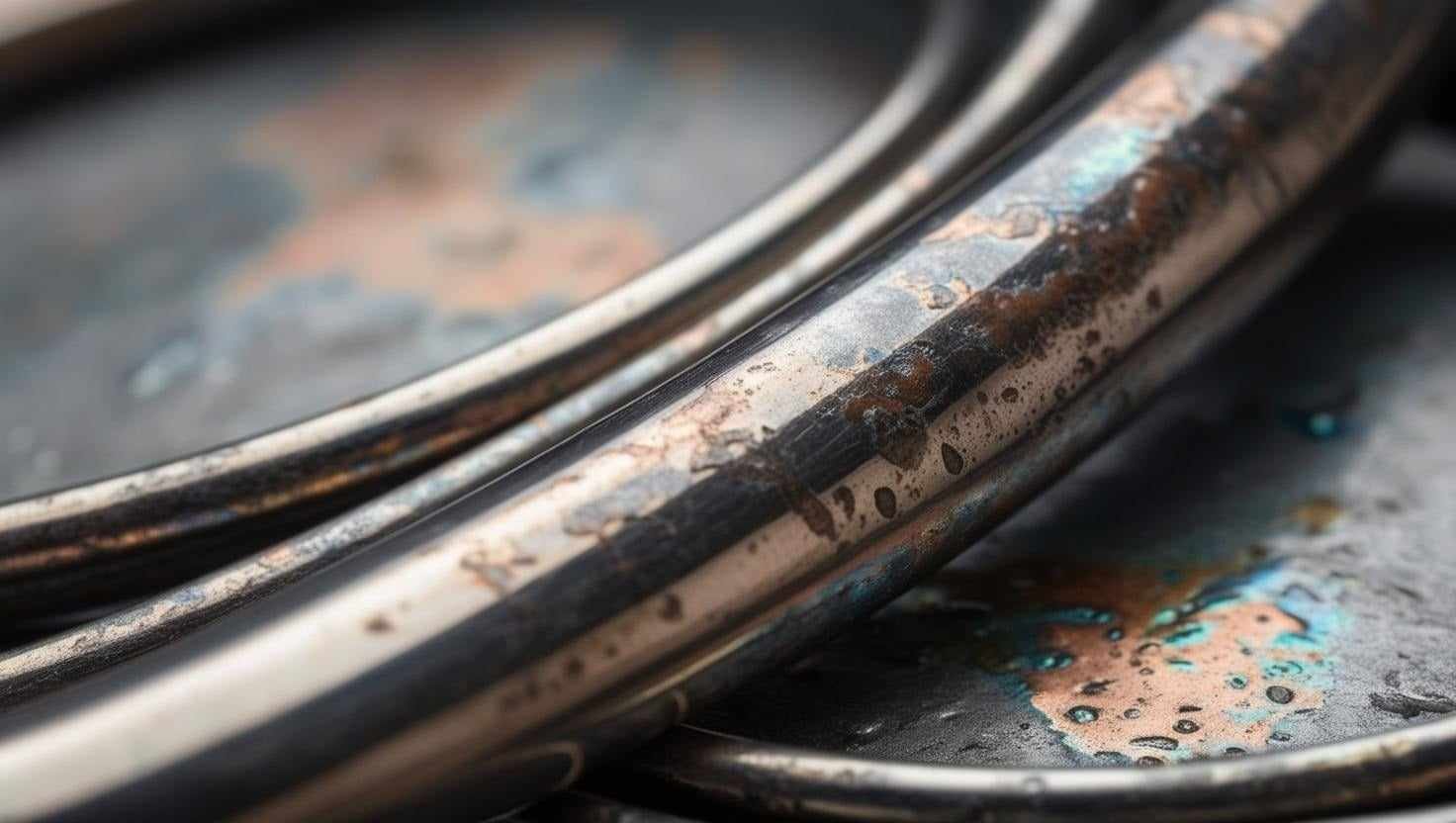Stainless steel is a popular choice for everything from kitchen appliances to jewelry, thanks to its sleek appearance and durability. But if you’ve ever noticed a dull or discolored spot on your stainless steel items, you might wonder—does stainless steel tarnish? Understanding how this material reacts to its environment can help you keep it looking its best.
You might assume stainless steel is completely immune to wear and tear, but even this resilient metal has its limits.
Factors like exposure to moisture, harsh chemicals, or improper care can impact its shine over time. Knowing what causes these changes and how to prevent them ensures your stainless steel remains as stunning as the day you got it.
What Is Stainless Steel?
Stainless steel is a corrosion-resistant alloy renowned for its strength, sleek finish, and wide range of applications. Its unique properties stem from its composition and the variety of grades available.
Composition And Characteristics
Stainless steel consists primarily of iron, chromium (at least 10.5%), and other elements like nickel, carbon, and molybdenum. Chromium forms a protective oxide layer on the surface, making stainless steel resistant to rust and staining. T
he material offers durability, resistance to heat, and a smooth, non-reactive surface, which is ideal for use in environments with moisture or high temperatures. Low maintenance and aesthetic appeal make it popular in kitchenware, medical tools, and architectural designs.
Types Of Stainless Steel
There are four main types of stainless steel, each designed for specific uses:
- Austenitic – Contains high chromium and nickel, offering excellent corrosion resistance and high ductility. Used for cookware, cutlery, and food-processing equipment.
- Ferritic – Composed mainly of chromium, it provides moderate corrosion resistance and is less ductile. Common in automotive parts and industrial equipment.
- Martensitic – Made with higher carbon content, this type is strong and wear-resistant but less corrosion-resistant. Used in knives, turbines, and dental tools.
- Duplex – Combines austenitic and ferritic structures, offering enhanced strength and corrosion resistance. Found in chemical plants, oil and gas industries, and marine applications.
Each type’s characteristics depend on its specific elemental makeup and heat treatment processes.
Do Stainless Steel Tarnish?
Stainless steel tarnishes less easily than other metals due to its chromium content, but it isn’t entirely tarnish-proof. Its resistance depends on the environment and how it’s maintained.
Understanding Tarnishing
Tarnishing involves a thin, discolored layer forming on a metal’s surface from reactions with external elements. For stainless steel, tarnishing typically appears as dullness, discoloration, or faint spotting. Chromium in stainless steel reduces tarnishing risks by forming a passive oxide layer, though this layer can weaken if exposed to harsh conditions or improper care.
- Moisture Exposure: Prolonged contact with water, especially saltwater, wears down the protective oxide layer.
- Harsh Chemicals: Bleach, acidic cleaning agents, and chlorine significantly increase the likelihood of tarnish.
- High Humidity: Humid environments accelerate surface reactions that dull stainless steel over time.
- Surface Damage: Scratches or abrasions expose underlying layers, making the metal vulnerable to tarnishing agents.
- Improper Cleaning: Using abrasive tools or skipping routine cleaning reduces shine and may result in tarnish deposits.
Regular care and proper handling help minimize these tarnishing factors.
Preventing Tarnishing In Stainless Steel
Minimizing tarnishing in stainless steel involves consistent care and proper handling. Adopting effective cleaning methods and regular maintenance ensures the longevity of your stainless steel items.
Proper Cleaning Techniques
Use a non-abrasive cloth and mild soap to clean stainless steel. Rinse thoroughly with warm water to remove residue. Dry the surface immediately using a soft microfiber towel to prevent water spots from forming.
Avoid using steel wool or harsh scouring pads as they can scratch the protective oxide layer. For tougher stains, opt for a paste of baking soda and water or specialized stainless steel cleaners designed to preserve the finish.
Recommended Maintenance Tips
Inspect and clean stainless steel regularly, especially after exposure to moisture or harsh conditions. Store items in dry, well-ventilated areas to prevent humidity-induced tarnish.
Apply a thin layer of mineral oil or a stainless steel conditioner monthly to enhance the surface’s luster and add a protective barrier. Avoid prolonged contact with acidic substances like vinegar or citrus juices to protect against discoloration.
How To Remove Tarnish From Stainless Steel
Removing tarnish from stainless steel restores its original shine without damaging the surface. Use proper cleaning solutions and follow a step-by-step approach for effective results.
Effective Cleaning Solutions
- Baking Soda Paste: Mix 1 tablespoon of baking soda with water to form a paste. Baking soda’s mild abrasiveness helps remove tarnish without scratching.
- White Vinegar: Soak a soft cloth in white vinegar and gently rub the tarnished area. Vinegar dissolves surface buildup caused by tarnishing.
- Stainless Steel Cleaners: Use commercial stainless steel cleaners designed for tarnish removal. These products protect the protective oxide layer while cleaning.
- Lemon Juice and Salt: Create a mixture of lemon juice and a small amount of salt to gently lift tarnish caused by oxidation.
- Clean The Surface: Wipe the stainless steel surface with a damp microfiber cloth to remove dust and debris.
- Apply Cleaning Solution: Use one of the recommended solutions, such as baking soda paste or vinegar, on the tarnished area.
- Rub Gently: Use a non-abrasive sponge or cloth to rub in the direction of the grain. Avoid circular motions to prevent surface damage.
- Rinse Thoroughly: Wash the surface with warm water to remove any residue from the cleaning agents.
- Dry Completely: Pat the surface dry using a soft, lint-free microfiber towel to avoid water spots.
- Polish For Shine: Apply a small amount of mineral oil or stainless steel polish with a clean microfiber cloth to restore luster.
Benefits Of Using Stainless Steel
Stainless steel offers numerous advantages that make it a preferred material across industries. Its unique properties ensure lasting functionality and visual appeal.
Durability And Longevity
Stainless steel resists corrosion and wear, ensuring an extended lifespan. Its chromium content forms a protective layer that shields against rust, tarnish, and environmental damage. This makes it ideal for demanding applications like kitchen appliances, healthcare equipment, and industrial tools.
Even with regular use, stainless steel maintains structural integrity and reliability, requiring minimal replacements over time.
Aesthetic Appeal And Versatility
Stainless steel’s sleek finish enhances the appearance of any space or product. Its polished surface is easy to maintain and retains its shine with proper care. The material suits both modern and traditional designs, making it popular for furniture, hardware, and jewelry.
Available in various grades and finishes, stainless steel adapts to diverse functional and decorative purposes, seamlessly blending style with practicality.
Conclusion
Stainless steel remains a reliable and stylish material for countless applications, but understanding its care is key to preserving its beauty. While it’s not entirely tarnish-proof, proper maintenance and cleaning can go a long way in preventing discoloration and dullness.
With the right techniques and a little effort, you can keep your stainless steel items looking as sleek and polished as the day you got them.
Frequently Asked Questions
Does stainless steel tarnish over time?
While stainless steel is highly resistant to tarnishing due to its chromium layer, it is not entirely tarnish-proof. Factors like prolonged moisture exposure, harsh chemicals, and improper cleaning can cause dullness or faint spots on the surface. Proper care minimizes tarnishing.
What causes stainless steel to lose its shine?
Stainless steel may lose its shine from exposure to moisture, high humidity, abrasive cleaning tools, harsh chemicals, and physical damage. These factors can weaken the protective chromium oxide layer, leading to discoloration.
How can I prevent tarnishing on stainless steel?
To prevent tarnishing, clean stainless steel regularly with a non-abrasive cloth and mild soap. Rinse, dry thoroughly, and avoid moisture build-up. Use a stainless steel conditioner or mineral oil monthly to enhance protection and shine.
What cleaning methods are safe for stainless steel?
Use a soft microfiber cloth, mild soap, and warm water. For tough stains, try a baking soda paste, white vinegar, or commercial stainless steel cleaner. Always clean in the direction of the grain and avoid abrasive tools like steel wool.
Can tarnish be removed from stainless steel?
Yes, tarnish can be removed by using a baking soda paste, white vinegar, or lemon juice with salt. Gently rub in the grain’s direction, rinse, dry thoroughly, and polish to restore shine. Avoid harsh scouring pads to prevent surface damage.
What are the benefits of stainless steel compared to other metals?
Stainless steel is durable, corrosion-resistant, and long-lasting. It offers a sleek, modern appearance and is versatile for use in kitchen appliances, jewelry, healthcare, and industrial tools. Its aesthetic and functional properties make it a preferred choice across industries.
What types of stainless steel exist, and how do they differ?
There are four main types: Austenitic, Ferritic, Martensitic, and Duplex. They differ in corrosion resistance, ductility, and applications. For example, Austenitic stainless steel is highly corrosion-resistant, while Martensitic is known for its strength and hardness.
Does exposure to acidic substances damage stainless steel?
Yes, prolonged contact with acidic substances can weaken the protective layer, causing discoloration or tarnishing. Wipe away acidic residues like lemon juice or vinegar promptly and clean the surface thoroughly to prevent damage.
How should stainless steel items be stored to prevent tarnishing?
Store stainless steel in a dry, well-ventilated area. Avoid humid environments, and ensure items are completely dry before storage. Use protective coverings or soft cloths if necessary to maintain their polished finish.
Why is regular maintenance important for stainless steel?
Regular cleaning and maintenance help preserve the appearance and functionality of stainless steel. Removing dirt, moisture, and chemical residues prevents tarnishing and discoloration, ensuring the material’s durability and long-lasting shine.

